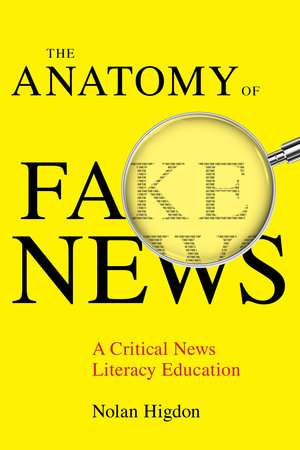by Nolan Higdon, author of The Anatomy of Fake News: A Critical News Literacy Education
Each year, Media Literacy Week emphasizes the power and impact of media literacy education in the United States. The host of Media Literacy Week in the U.S., the National Association for Media Literacy Education (NAMLE), has dedicated one day between October 26-30, to each of the five defining characteristics of media literacy – Access, Analyze, Evaluate, Create, and Act.
This year media literacy education seems particularly important. 2020 is an election year where discourses about the relationship between media and our democracy have centered on deep fake videos, fake news hysteria, the popularity of documentaries such as “The Social Dilemma,” concerns over foreign actors, video conferencing improprieties, stolen laptops, and the shift to distance education for many students.
I explore the relationship between many of these issues and American democracy in my recent book, Anatomy of Fake News: A Critical News Education. Despite glaring contradictions, the U.S. has often defined itself as a nation dedicated to democracy. In a democracy, media plays a crucial role in shaping the attitudes and behaviors of the electorate. In fact, the nation’s Bill of Rights extends constitutional protections to one private profession: the press. The federal government has also subsidized the press for centuries to varying degrees. They recognized that an effective democracy is dependent upon a well-informed public who receives information from a free and accurate press.
“Our best hope does not rely in techno-utopian censorship and innovation, AI or bots, outside fact-checkers, or McCarthy-like lists of good and bad news outlets. Instead, we need to offer Americans access to a critical news literacy education.”
Nolan Higdon
As I discuss in the Anatomy of Fake News, fact-based journalism still exists. However, the public struggles to identify journalism as they are inundated by fake news content – from nation states, political parties, the traditional press, self-interested actors, and satirists – and not just in newspapers and other media outlets, but also on social media platforms. As my research shows, fake news has been a problem facing American democracy for centuries. However, the consolidation of American media corporations coupled with the widespread access to the Internet has exacerbated the problem.
Our best hope does not rely in techno-utopian censorship and innovation, AI or bots, outside fact-checkers, or McCarthy-like lists of good and bad news outlets. Instead, we need to offer Americans access to a critical news literacy education: One that empowers students to autonomously access, analyze, evaluate, create, and act with news content in a way that accounts for the impacts of power and ideology on our information systems. This is why I included a Fake News Detection Kit in my book as a resource for citizens to delineate fake news from journalism. The Fake News Detection Kit provides ten simple questions news users should consider when analyzing content news content.
Given what 2020 has revealed, it is more urgent than ever before, that we spend U.S. Media Literacy Week reflecting on what we can do to strengthen our critical news literacy skills.

